
This week the Wednesday Comics Reviews team does its best to review the most packed week of the year, including books like Bitter Root: The Next Movement #1, Free For All #1, We’re Taking Everyone Down With Us #1, You’ll Do Bad Things #1, and many, many more. We also look ahead at a new title eligible for pre-order, specifically forthcoming graphic novel, Dr. Werthless: The Man Who Studied Murder (And Almost Killed the Comics Industry). Plus, as always…The Prog Report!

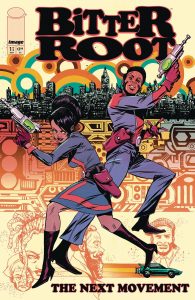 Bitter Root: The Next Movement #1
Bitter Root: The Next Movement #1
Writers: Chuck Brown and David F. Walker
Artist: Sandford Greene
Colorist: Matt Herms
Letterer: Hassan Otsmane-Elhaou
Publisher: Image Comics
Review by Jordan Jennings
I will be honest. I came into Bitter Root: The Next Movement #1 only knowing that it was an afrofuturism story focusing on the civil rights movement and that the creative team produced one of my favorite comics in the last ten years Power Man and Iron Fist. What I didn’t know was that this was a sequel series to an original series titled Bitter Root from 2018. It just slipped under the radar for me and I am now wanting to check it all out if it’s anything like Bitter Root: The Next Movement #1.
Writers Chuck Brown and David F. Walker manages to create a world that feels sadly believable and fantastical all at the same time. The believability comes from the fact the story is set in the American Deep South. I am an American Southerner. I have lived in Tennessee my whole life and while I am a white man, I cannot and will not ignore my region’s awful history when it comes to the treatment of Black Americans and other minorities.
Given today’s political climate, this story feels even more resonant than ever before. Brown and Walker challenge the idea that racism can be defeated and ignored by showing that the crisis of racism can lay seemingly dormant and fester into something even more toxic than before. The Jinoo are the primary supernatural enemy of the book. They are humans poisoned by their greed, hate, and racism into these almost eldritch horror like in their appearance. Much like how people proclaimed racism’s defeat following the election of President Barack Obama in 2008 but ignored the red flags of the cancer growing that took the form of the current president, the Jinoo metastasized and spread through the south. It is a compelling read that just feels timely in ways that I wish weren’t true.
The art by Sandford Greene is as phenomenal as always. Greene’s use of bold outlines and dynamic body language makes the pages absolutely pop off the page. The designs of all of the characters are visually distinct with each getting their own silhouette and profile. It makes it easy to follow what is happening on the page considering this book has a large cast of characters from the onset. Green’s page layouts make frequent use of panel inlays that do a wonderful job setting the tone and scale of a scene.
Matt Herms does a stellar job with the coloring in this issue. The more supernatural scenes are colored in these rich purples and reds that sell the horror aspect so well. Contrasted to the more earth tones found in the scenes grounded in reality. The mood of each scene is perfectly set with Herms colors and I just felt the need to give them a shoutout.
Overall, I found Bitter Root The Next Movement #1 to be a great start to this new series. The series is extremely new reader friendly and takes you into a rich world that feels extremely lived in. The afrofuturistic setting provides a world that is fantastical but eerily prescient of today’s reality. Additionally, the backmatter material Bitter Truths is a revelatory series of essays, interviews, and poems by some of the best and brightest black minds in fiction today that I implore everyone to read in addition to checking out this fantastic comic. The essay by John Jennings really hit home and helped inform some of my analysis in this review. I highly recommend this series to anyone and everyone.
Final Verdict: BUY

 Free For All #1
Free For All #1
Writer/Artist: Patrick Horvath
Publisher: Oni Press
Review by Khalid Johnson
I’m going to start by saying that I cheered by the conclusion of this story. It’s concise with some solid action design as Patrick Horvath does it all. It’s also catharsis that is much needed, especially now. While sitting and simply agreeing with a piece of media is not going to bring about a better world, it can at least help shape our imaginations of a better world.
In Free for All, we see a future where wealth has a redistribution system; being pooled for the welfare of the people instead of hoarded by the elite. The elites are given a choice to give up an allotted amount of their ill-gotten gains or fight like gladiators in an arena to defend their wealth for the enjoyment of the people. There is certainly an ethics question as people cheer on brutal violence, but isn’t the exploitation of labor and extraction of resources also a brutal form of violence?
Horvath places his focus on two central characters, using them as a framing device for an argument against hoarding wealth through revenge between former romantic partners. From the colors, expressions, tech, costuming and combat, this story delivers. I think there is a catharsis for the people in the world of Free for All and for the readers, and to this, what we are presented is the story’s reality that there were mechanisms in place where violence could have been avoidable; if only people would contribute to the welfare of everyone.
If we can imagine a world where the welfare of the people comes first, then we can work to actualize it. Catharsis is great, this story is great (I can’t recommend it enough) and there’s work to be done outside to realize a better world.

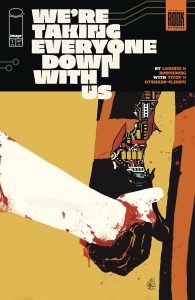 We’re Taking Everyone Down With Us #1
We’re Taking Everyone Down With Us #1
Writer: Matthew Rosenberg
Artist: Stefano Landini
Letterer: Hassan Otsmane-Elhaou
Colorist: Roman Titov and Jason Wordie
Publisher: Image Comics
Review by Jared Bird
Annalise is a thirteen year old kid, who just wants to spend time with her father as opposed to hanging out with his variety of colorful robots. The only issue? Her father is in the midst of vital, world-changing research, and when he is attacked by a mysterious spy organisation, Annalise’s life is set to change forever. The newest comic from writer Matthew Rosenberg, working alongside the fantastic artist Stefano Landini, We’re Taking Everyone Down With Us is unlike anything else being published right now. Part coming-of-age story, part science-fiction thriller, and part spy adventure, it’s sure to be one of the most unique comics you’ll check out this year.
Life is hardly normal when your father is a mad scientist, but when he is killed by the world’s greatest spy, Annalise is torn between revenge and change. Accompanied by her dead father’s robot bodyguard, this miniseries shines in its identity. It’s eccentric, funny and full of heart, wearing its influences on its sleeves whilst also trying to tell a unique story that can appeal to a huge variety of different audiences and demographics. Whilst this approach often ends up with a ‘jack of all trades, master of none’ situation, this series manages to make it work, thanks to the skillful work of the creative team involved who make every disparate style and plot thread feel like parts of one larger whole.
Matthew Rosenberg’s writing is great throughout. He continues to prove himself to be one of the funniest writers in comics, telling stories with an element of sincerity that they wear on their sleeves. Moments in this issue made me laugh out loud, but the mysteries that propel the series are also set up gracefully and leave the reader wanting more. It ends on a fantastic cliffhanger as well, which will be sure to get readers invested. If you are new to Rosenberg’s work, this is a great place to start, and if you are already a fan, it’s almost a certainty you’ll enjoy it.
Stefano Landini’s artwork is absolutely stellar. Aided by the incredible work of colorists Roman Titov and Jason Wordie, Landini gives the series an exciting and energetic visual style, with a propulsive sense of energy that keeps the reader entertained even during the more exposition-heavy moments of dialogue. He experiments with style and form in an interesting way as the issue goes on, and is sure to experiment more over the course of the series.
Overall, We’re Taking Everyone Down With Us #1 is a great read, an exciting start filled with mysteries, humour and heart. With witty writing and excellent art, this book combines the talents of two phenomenal creators to make something unique and interesting. There is absolutely something for almost everyone in this comic, and it’s sure to be a crowd pleaser. I mean, who doesn’t love a vaguely homicidal lovable robot?

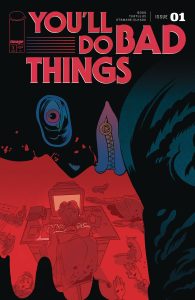 You’ll Do Bad Things #1
You’ll Do Bad Things #1
Writer: Tyler Boss
Artist: Adriano Turtulici
Letterer: Hassan Otsmane-Elhaou
Designer: Dylan Todd
Publisher: Image Comics
Review by Tim Rooney
It’s best to go into You’ll Do Bad Things with as little information as possible.
Not because the book is full of shocks and surprises but because writer Tyler Boss’s story benefits from its reader being bounced around the shifting tones and genres and comics storytelling conventions of this first issue, which follows a writer suffering from a very specific type of writer’s block. It’s no surprise this comic plays with classic language and iconography of golden and silver age comics, as Boss is as much a designer as he is an artist and writer. His style is full of deliberate precision that almost obsessively plays with form and function in his solo work.
That same playful metatextual poking is present here, and artist Adriano Turtulici is a game creative partner in the effort. In the opening pages, Turtulici’s layouts and melodramatic staging screams of romance comics, with a CMYK color palette that works as both retro throwback and pulsing nightclub colors that highlight the hip urban feel of the world. To push the romance Boss’s script calls for thought balloons to evoke the same old-school feeling, with Hassan Otsmane-Elhaou giving a modern lettering flare. The internal monologue runs for several pages and Otsmane-Elhaou packs the balloons with words in pulsing size, the bubbles barely containing the frantic thoughts.
Everything shifts on a dime from there, with Turtilici effortlessly shifting his layouts to something more tense and staccato as compared to the romantic, intimate opening pages. Boss and Turtulici pull back again, separating fiction and reality through the use of a creative double-page spread that emphasizes the artificiality of the narrative. Though the book deals with writers and stories, and there are shifts in how Turtulici constructs his page as the disparate scenes unfold and derail, he does not drastically shift his actual style, and the same kind of off-kilter coloring continues no matter what level of narrative. It adds an unsettling uncertainty to the pages–not because there is a fear of anything supernatural but merely that there is something dark hiding amidst even the most normal, unassuming people.
This is a real showcase of a debut issue that is best experienced firsthand. Highly recommended!

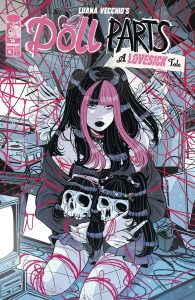 Doll Parts: A Lovesick Tale #4
Doll Parts: A Lovesick Tale #4
Writer / Artist: Luana Vecchio
Translator: Edward Caio
Publisher: Image Comics
Review by Jared Bird
Doll Parts: A Lovesick Tale reaches its devastating and explosive conclusion this week as writer / artist Luana Vecchio’s critically acclaimed prequel comes to a close. Madeleine has been abused, traumatised and left permanently scarred, and as she reaches adulthood, she has to face whether she is able to escape the violent cycle she’s found herself in. Will she submerge into the darkness and be reborn as someone else entirely?
Every issue of Doll Parts has pushed the boundary of what people might expect is appropriate for comics from a major publisher, but it never feels exploitative or simply for shock value. Vecchio expertly utilises sexuality and violence as a core element of the story, exploring the impact that cycles of abuse can have on someone, particularly an impressionable youth with unrestricted internet access. It feels all too primal and real, as if Vecchio is pulling the bandage off of a raw wound that no one wants to look at or talk about. Maddie’s story is something people experience to an extent every day, particularly women, and yet it’s not addressed, often being suppressed instead. Maddie has been depersonalised and traumatised to the extent she doesn’t even recognise herself, and the reader has been alongside that process every step of the way. Reading the line ‘These are just doll parts, with no value… Whoever wants them can keep them’ enforces the idea that the reader themselves has to consider why and how they engage with media, and the real and potentially damaging impacts of whatever it is they enjoy.
The story’s conclusion is devastatingly sad but emotionally triumphant at the same time. It’s not emotionally simple and leaves the reader to sit and deal with the ambiguity of the feelings involved and try to make up their own mind about how they feel about it. It’s bold for an up-and-coming creator, but Vecchio’s bravery pays off, because the story feels like it’s been carefully crafted to be as resonant and complex as possible. The sequences of Maddie’s visceral hallucinations perfectly utilise the form of comics to amplify the terror, pleasure and anxiety she feels, and at every possible corner the narrative ensures that you are completely within Mad’s emotional headspace. Aided by translator Edward Caio, the dialogue is raw and vulnerable but never feels cringeworthy or falsely pretentious. At the core of the series is a sense of sincerity and genuine heart, which makes the inevitable and tragic end all the more devastating.
Vecchio continues to shine as one of the best artists in the industry today. She has an excellent sense of panel layouts, pacing and page design, with every individual panel feeling important and memorable in some measure. She’s phenomenal at conveying violence with a sense of gruesome brutality where it makes you wince just as viewing real bloodshed might. Every aspect of the book feels well thought out, and every page is filled with details that help further the emotional reality of Maddie’s situation. It helps make her paranoia feel palpable and realistic, as if you’ve been submerged directly into her perspective and mindset. Don’t let the bright colors fool you, this book is as dark as it gets, and contains triggering subject matter that might not be appropriate for all readership. It feels as if Vecchio is bringing attention to such subject matter for the sake of awareness however, and it never feels manipulative or vindictive. Some of the most potentially triggering elements are portrayed with relative restraint, which to me is a clear sign that Vecchio is not out to incite controversy. It’s all part of the narrative she is trying to tell, exploring how one person gets caught up in a vicious and inescapable cycle of morbid sexuality and graphic violence and what that does to a person.
In the opinion of this humble critic, Doll Parts: A Lovesick Tale #4 is masterful. Vecchio’s comic is not for the faint of heart, but it never feels malicious or exploitative. It’s telling an important and moving story, one that is all too real for so many. Demonstrating the best artwork and writing of her career so far, the series has marked Vecchio’s biggest evolution yet as a creative, reaching new heights and setting an exciting standard as a trailblazing comics creator. At the core of this comic is something deeply human and incredibly timely, an exploration of trauma and fear and how the systems of the world exploit the vulnerable. It is rare to find a comic that is so incredibly dedicated to telling the story it wants to tell, without fear or hesitation. A book like that stands out and should be read, because it’s putting the process of creating art first above being a product. There are monsters out there, and the world needs to be aware.

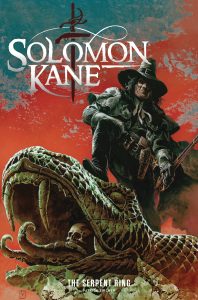 Solomon Kane: The Serpent Ring #1
Solomon Kane: The Serpent Ring #1
Writer: Patrick Zircher
Illustration: Patrick Zircher
Letters: Richard Starkings & Comicraft’s Tyler Smith
Publisher: Titan Comics
Review by Clyde Hall
My first encounter with the Puritan swashbuckler Solomon Kane was thanks to Marvel Comics and their 1970s magazine adaptations. Those exposures led me to seeking out Robert E. Howard’s original stories, but unlike his Conan works, which captivated what seemed a larger audience, the Kane chronicles drew me in completely. I devoured them, and eventually even tracked down and feasted on the Kane stories left incomplete at the time of Howard’s passing.
The Marvel comics adaptations may have been my gateway, but those original Solomon Kane stories are what made him my favorite Howard character after Sailor Steve Costigan and his doppelgänger Dennis Dorgan. And being honest, a lot of time passed between my long-ago Kane comic reads and picking up the pulp stories. The comics presented an interesting character, the soldier and adventurer and Puritan believer all rolled into one.
But the stories made Kane breathe, and I’ve often thought about the gulf between the original tales and those initial graphic story treatments. When I saw Titan Comics launching a new Kane title with artist Patrick Zircher illustrating and scripting it, my curiosity took a piquing.
Zircher doesn’t disappoint.
He gives us a Solomon Kane performing lawful English service as a privateer on behalf of Queen Elizabeth I. With a letter of marque, he helps fill her royal coffers as part of a crew preying on competing seafaring nations, capturing their cargos of spices and gold, claiming their merchant ships for conversion to military vessels boosting the English fleet. Which leaves our Puritan ‘Sword of Vengeance’ characteristically torn between honorable duty with his country’s approval and the moral dilemma of waging peacetime war in the name of bloody but legal piracy. It’s perfect framing for Kane’s sense of justice while navigating a Godly path against a background of international politics, conflicts of faith, and colonization.
Zircher carves Kane’s profile deeper when, after mistakenly killing a Portuguese crewman trying to parley a surrender, the Puritan swordsman honors the dying man’s request. He has an artifact which must be delivered to his brother, a scholar in Vienna. It’s the final step fulfilling an expedition funded by a Knight of Malta, and he entrusts the item to Kane’s keeping. Solomon gives his oath that it will reach the man’s family, not end up part of the ship’s plunder.
As Solomon begins the first part of his overland journey to reach this scholar in Venice, the lone traveler is set upon by highwaymen looking to relieve him of valuables, steed, and life. Which frames in a most exciting manner the other half of Kane’s nature: His merciful and peaceful path, when blocked by those dedicated to wicked ways and evil intent, is quickly and mercilessly cleared. Meanwhile, evidence rises suggesting that at least a portion of the evil Kane is set against during his quest is not of human origin.
The introductory issue is supremely balanced between setting details, history, characters delineated through action, and a steady storytelling stride. Solomon Kane has seldom looked better in a comic format, and based on my experience, he’s never read more like the Howard character of those original stories.
As for Zircher’s other balanced duties, script and art, this title is in the current category of comics where the words and images from a single source exceed efforts from many larger creative teams. I’m mostly familiar with his past work on Young Justice, but his rendering of Elizabethan life is powerful. Be it reavers storming the deck of a masted caravel or learned scholars traversing manuscript-lined halls of the Biblioteca Marciana, his detail and panel placement gives the narrative a consistent, driving pulse.
The end result is a first installment of Solomon Kane: The Serpent Ring that’s been clearly and carefully crafted by Zircher along with lettering talent Richard Starkings and Comicraft’s Tyler Smith. It handles Kane, along with elements from other Howard tales, with an elegant reverence. It’s not rushed. It’s plotted, planned, and executed with pride.
In that way, it stands apart from most of my monthly comic reads in ways that echo its Elizabethan setting, or at least the Robert E. Howard pulp simulation of it. Kane is diligent. Persistent. Not one to pledge his troth to causes he doesn’t fully believe in. With this issue, readers will find Zircher and associates have this in common with their hero.

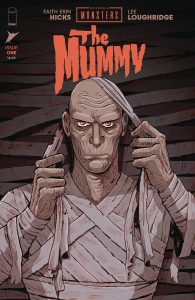 Universal Monsters – The Mummy #1
Universal Monsters – The Mummy #1
Writer/Artist: Faith Erin Hicks
Colors: Lee Loughridge
Letters: Hassan Otsmane-Elhaou
Publisher: Skybound/Image Comics
Review by Clyde Hall
Of all the Universal Monsters, the original Mummy may be the most unloved. Which is ironic, given how much Imhotep’s tale involves three thousand years of suffering on behalf of the woman he loves. When choosing the annual Halloween season Universal retrospectives at the local library, our selection committee repeatedly passed over 1932’s The Mummy as ‘boring’. I blame the too-brief appearance of star Boris Karloff in the iconic Jack Pierce bandage-wrapped profile and too much time as his prune-faced alias, Ardath Bey. The Mummy even gets ‘band-aid breath’ short shrift in 1987’s The Monster Squad.
Another underwhelming part of Mummy lore carrying blame with modern audiences might be in the storyline’s focus. The crux of it deals with Imhotep’s quest for reuniting with his lost love. Another portion deals with the humans defending Helen Grosvener, the reincarnated Anck-es-en-Amon, from her ancient Egyptian beau. Helen’s part of the tale, however, gets less emphasis.
In Universal Monsters: The Mummy, Faith Erin Hicks works on exploring the other half of this doomed romance. And in the first issue, she works it well. Her Helen, like the character in the 1932 film, is a child of two worlds. Her father is a British archeologist. Her mother comes from a long and distinguished Egyptian bloodline. Hicks explores both worlds, both heritages, pulling Helen between them. First, as a child grappling with the duality of her nature and the differing worlds it represents, and later as a teen understanding more fully her alienation within both cultures.
In the background, events of the 1932 film unfold. Eventually, they intersect with young Helen as she plies rebellious teen resistance against expectations of both her parents and her peers. As intelligent, headstrong, and proud as Helen is, can she resist the undead force of nature which has waited 3,700 years for their reunion? And by reconnecting with her previous life as Anck-es-en-Amon, will she gain insights into what has been and what could be again if Imhotep’s schemes succeed?
Nearly every element in the first issue comes faithfully, care of the classic 1932 Mummy film. They’re simply refocused and expanded on, with parts which were mentioned but quickly brushed over cinematically examined more closely and through an empathic lens from Helen’s perspective.
Most of us can identify with being stuck in the middle, friendly with one clique, sharing interests with another, while simultaneously belonging to neither. Hicks makes us experience a similar situation through Helen’s eyes. It places us firmly in our hero’s corner even before her undead suitor arrives and preps us for Imhotep’s manipulations in the coming issues.
While her story works on several levels, Hicks’ artwork on this issue captures the right time periods and background elements well enough. But overall, and purely for my taste, it has a lightweight aesthetic for such a monsterish story of long-suffering love denied. The mood of impending danger, one even the film managed, was exemplified by Karloff’s intense gaze, reflecting a vision of inhuman longing and unnatural obsession. Such a visual impact is lessened in this adaptation by largely caricatured representations of the characters involved, major as well as secondary.
But as this issue centers on young Helen more than the Egyptologists or the Mummy himself, that may be part of the storytelling set for change as the issues unfold and the stakes rise. The creative team has already added attractive layers to the original tale of Imhotep and Anck-es-en-Amon with this start. And they’ve kept focus firmly on the 1932 classic without nods to any later entries in the franchise. We can have confidence they will build on that foundation and continue the inspired Skybound/Image iterations of these quintessential Universal monster stories.
Rapid Wednesday Comics Reviews
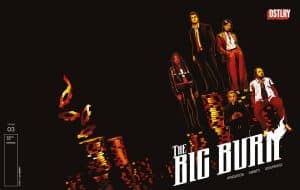 Big Burn #3 (DSTLRY): In case you haven’t been reading this very fun book, the high concept is that it’s a heist story, but instead of stealing jewels or riches, our characters here have to break into hell to steal back their souls. The book is exactly as fun as that, and it hits all the notes one expects from a heist story, also mixing in some fun theological touches related to heaven and hell. It doesn’t really reach for anything beyond that extremely fun concept, but it also doesn’t need to. It’s great. Big Burn is by writer Joe Henderson, artist Lee Garbett, colorist Lee Loughridge, and letterer Lucas Gattoni. —Zack Quaintance
Big Burn #3 (DSTLRY): In case you haven’t been reading this very fun book, the high concept is that it’s a heist story, but instead of stealing jewels or riches, our characters here have to break into hell to steal back their souls. The book is exactly as fun as that, and it hits all the notes one expects from a heist story, also mixing in some fun theological touches related to heaven and hell. It doesn’t really reach for anything beyond that extremely fun concept, but it also doesn’t need to. It’s great. Big Burn is by writer Joe Henderson, artist Lee Garbett, colorist Lee Loughridge, and letterer Lucas Gattoni. —Zack Quaintance Falling In Love on the Path to Hell #7 (Image Comics): After a few months back, it’s back — everyone’s favorite comic about an old west gunslinger and a classic samurai falling in love after they die and go to hell and find themselves embroiled in a war for control of that hell. I’m being cheeky and making it sound more complicated than it is, because this is a deceptively simple and straight-up excellent comic, one that works because of its deep characterization and stunning artwork. This first issue of the second story arc is an absolute stunner, serving up the best visuals yet (which is a high bar in the context of this series), as the heroes here set up a lot of new tension for a coming conflict with elevated stakes. I’m rooting for these two crazy, lost-in-time, dead kids, and you should be too. This book is excellent. Falling In Love on the Path to Hell is by writer Gerry Duggan, artist Garry Brown, colorist Chris O’Halloran, and letterer Joe Sabino. —Zack Quaintance
Falling In Love on the Path to Hell #7 (Image Comics): After a few months back, it’s back — everyone’s favorite comic about an old west gunslinger and a classic samurai falling in love after they die and go to hell and find themselves embroiled in a war for control of that hell. I’m being cheeky and making it sound more complicated than it is, because this is a deceptively simple and straight-up excellent comic, one that works because of its deep characterization and stunning artwork. This first issue of the second story arc is an absolute stunner, serving up the best visuals yet (which is a high bar in the context of this series), as the heroes here set up a lot of new tension for a coming conflict with elevated stakes. I’m rooting for these two crazy, lost-in-time, dead kids, and you should be too. This book is excellent. Falling In Love on the Path to Hell is by writer Gerry Duggan, artist Garry Brown, colorist Chris O’Halloran, and letterer Joe Sabino. —Zack Quaintance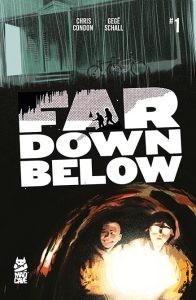 Far Down Below #1 (Mad Cave Studios): This is a charming book to read and look at; artist Gegê Schall brings such a vibrant energy to the world through strong expressive character art, halftones, and wow the colors in this issue feel straight out of Ghibli film. The use of light is such a strength across the board, especially when the story moves underground and the shadows and blacks encroach. The spreads in this first issue are stunning and there’s a sequence early in that is masterfully maneuvered through, highlighting the interests of the characters in tandem with Chris Condon’s writing. Condon really captures the spirit of those 80s kid-led sci-fi films (maybe with a bit more swearing), but he’s really got the energy down as the kids are spunky and complement each other well. I appreciate the pacing here, burying the mystery in 1865 with the scientists who make their discovery as we move to the time that the story takes place, 1983. I think this is a strong first issue, though man, these scientists feeling they were above the Civil War (while literally below it), remarking that the deaths were pointless, feels like they bought into the Lost Cause. It doesn’t take a scientist to know that the Civil War was fought over slavery and the attempt to expand slavery beyond the South. That being said, the bulk of this issue is spent building out the relationship of our two main characters before they fall into the mystery that the book opens with. I think that is a strength because they are a joy to read and it will make the mystery underground even more engaging to explore. —Khalid Johnson
Far Down Below #1 (Mad Cave Studios): This is a charming book to read and look at; artist Gegê Schall brings such a vibrant energy to the world through strong expressive character art, halftones, and wow the colors in this issue feel straight out of Ghibli film. The use of light is such a strength across the board, especially when the story moves underground and the shadows and blacks encroach. The spreads in this first issue are stunning and there’s a sequence early in that is masterfully maneuvered through, highlighting the interests of the characters in tandem with Chris Condon’s writing. Condon really captures the spirit of those 80s kid-led sci-fi films (maybe with a bit more swearing), but he’s really got the energy down as the kids are spunky and complement each other well. I appreciate the pacing here, burying the mystery in 1865 with the scientists who make their discovery as we move to the time that the story takes place, 1983. I think this is a strong first issue, though man, these scientists feeling they were above the Civil War (while literally below it), remarking that the deaths were pointless, feels like they bought into the Lost Cause. It doesn’t take a scientist to know that the Civil War was fought over slavery and the attempt to expand slavery beyond the South. That being said, the bulk of this issue is spent building out the relationship of our two main characters before they fall into the mystery that the book opens with. I think that is a strength because they are a joy to read and it will make the mystery underground even more engaging to explore. —Khalid Johnson
FOC Watch
This book is available for pre-order now.

 Dr. Werthless: The Man Who Studied Murder (And Nearly Killed the Comics Industry)
Dr. Werthless: The Man Who Studied Murder (And Nearly Killed the Comics Industry)
Writers: Harold Schechter and Eric Powell
Artist: Eric Powell
Designer: Phil Balsman
Publisher: Dark Horse Comics
Due Out: July 2, 2025
Review by Zack Quaintance
One of my favorite graphic novels in the past five years or so was the grisly true crime book, Did You Hear What Eddie Gein Done? by the team of Harold Schechter and Eric Powell. It had the benefit of being based on a darkly fascinating real story, but it was also masterfully told, armed as it was with the artwork of Powell (The Goon). Now, that team is reuniting for a new book due out this summer, one that’s available for pre-order now.
It’s another graphic novel that uses reality as its basis, taking a look at one of the most influential figures (for better or worse) in the history of comics — Dr. Frederic Wertham. I haven’t had a chance to read the book in full just yet — it’s a dense and complicated read — but I wanted to feature it here all the same, while it’s still out for pre-order, because I think it’s fascinating.
It’s easy in our circles — the type of people who write for and read this site — to condemn Wertham, to simplify him as a one-dimensional monster who set back an entire medium for decades to further his own career and stature. But, as the saying goes, people contain multitudes, and this book explores that. I can’t wait to finish reading it (we’ll have a full review when the book hits stores in July), and I suggest pre-ordering your copy now — this is likely to be one of the books of the year.
The Prog Report
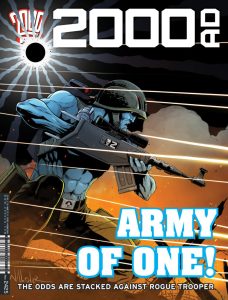 2000AD 2425 (Rebellion Publishing): With a bumper issue on the way next, this week’s Prog serves up mostly endings and stand-alone stories. The two strips that conclude this week are Judge Dredd: The Shift and Full Tilt Boogie: Book Three. Dredd is by writer Ken Niemand, artist Nick Percival, and letterer Annie Parkhouse, and it serves up an ominous ending, wherein it’s made clear something bad is coming for Dredd. Full Tilt Boogie, meanwhile, is by writer Alex De Campi, artist Eduardo Ocana, colorist Giulia Brusco, and letterer Simon Bowland, and it’s a sort of epilogue after the action-heavy climax in last week’s double-sized strip. It’s a quick read that lands our characters in a place that feels like an ending, but flexible enough that their adventures could continue at some point. Personally, I’m hopeful that they do. Portals and Black Goo gives us a penultimate chapter this week, and I’ll discuss that one further next week as it concludes. Finally, this issue features a stand-alone story, Rogue Trooper: The Stack by writer Karl Stock, artist John McCrea, colorist Jack Davies, and letterer Jim Campbell. McCrea art is always an event for me, and this story is no exception. This comic gives McCrea a chance to go wild on some creepy ecological sci-fi landscapes as well as a grungy neglected deep jungle outpost, and it’s all a ton of fun — even though it does get violent and gruesome and mildly torture-y (this is a war comic, after all). This week’s cover (above) is by Ben Willsher. As always, you can pick up a digital copy of The Prog here. —Zack Quaintance
2000AD 2425 (Rebellion Publishing): With a bumper issue on the way next, this week’s Prog serves up mostly endings and stand-alone stories. The two strips that conclude this week are Judge Dredd: The Shift and Full Tilt Boogie: Book Three. Dredd is by writer Ken Niemand, artist Nick Percival, and letterer Annie Parkhouse, and it serves up an ominous ending, wherein it’s made clear something bad is coming for Dredd. Full Tilt Boogie, meanwhile, is by writer Alex De Campi, artist Eduardo Ocana, colorist Giulia Brusco, and letterer Simon Bowland, and it’s a sort of epilogue after the action-heavy climax in last week’s double-sized strip. It’s a quick read that lands our characters in a place that feels like an ending, but flexible enough that their adventures could continue at some point. Personally, I’m hopeful that they do. Portals and Black Goo gives us a penultimate chapter this week, and I’ll discuss that one further next week as it concludes. Finally, this issue features a stand-alone story, Rogue Trooper: The Stack by writer Karl Stock, artist John McCrea, colorist Jack Davies, and letterer Jim Campbell. McCrea art is always an event for me, and this story is no exception. This comic gives McCrea a chance to go wild on some creepy ecological sci-fi landscapes as well as a grungy neglected deep jungle outpost, and it’s all a ton of fun — even though it does get violent and gruesome and mildly torture-y (this is a war comic, after all). This week’s cover (above) is by Ben Willsher. As always, you can pick up a digital copy of The Prog here. —Zack Quaintance
Read more entries in the weekly Wednesday Comics reviews series!
Next week, things slow down a bit but we’ve still got I Was a Fashion School Serial Killer #1, Past Time #1, Plague House #1, and much more!


Source link
















